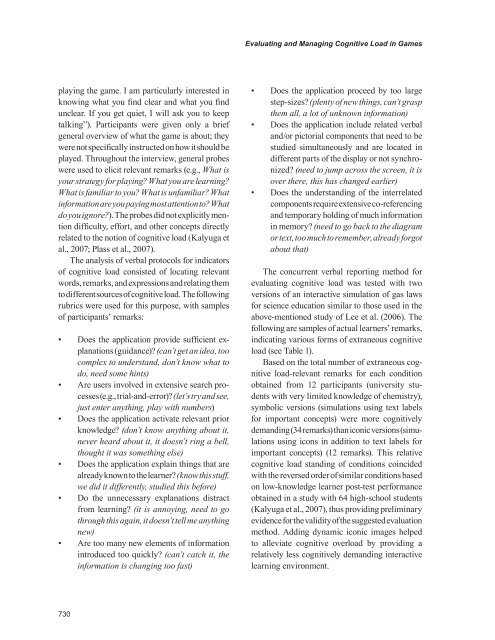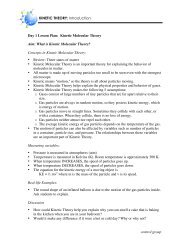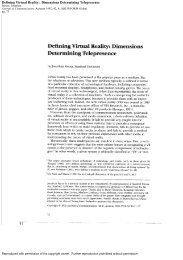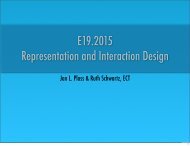Evaluating and managing cognitive load in educational games
Evaluating and managing cognitive load in educational games
Evaluating and managing cognitive load in educational games
You also want an ePaper? Increase the reach of your titles
YUMPU automatically turns print PDFs into web optimized ePapers that Google loves.
<strong>Evaluat<strong>in</strong>g</strong> <strong>and</strong> Manag<strong>in</strong>g Cognitive Load <strong>in</strong> Games<br />
play<strong>in</strong>g the game. I am particularly <strong>in</strong>terested <strong>in</strong><br />
know<strong>in</strong>g what you f<strong>in</strong>d clear <strong>and</strong> what you f<strong>in</strong>d<br />
unclear. If you get quiet, I will ask you to keep<br />
talk<strong>in</strong>g”). Participants were given only a brief<br />
general overview of what the game is about; they<br />
were not specifically <strong>in</strong>structed on how it should be<br />
played. Throughout the <strong>in</strong>terview, general probes<br />
were used to elicit relevant remarks (e.g., What is<br />
your strategy for play<strong>in</strong>g? What you are learn<strong>in</strong>g?<br />
What is familiar to you? What is unfamiliar? What<br />
<strong>in</strong>formation are you pay<strong>in</strong>g most attention to? What<br />
do you ignore?). The probes did not explicitly mention<br />
difficulty, effort, <strong>and</strong> other concepts directly<br />
related to the notion of <strong>cognitive</strong> <strong>load</strong> (Kalyuga et<br />
al., 2007; Plass et al., 2007).<br />
The analysis of verbal protocols for <strong>in</strong>dicators<br />
of <strong>cognitive</strong> <strong>load</strong> consisted of locat<strong>in</strong>g relevant<br />
words, remarks, <strong>and</strong> expressions <strong>and</strong> relat<strong>in</strong>g them<br />
to different sources of <strong>cognitive</strong> <strong>load</strong>. The follow<strong>in</strong>g<br />
rubrics were used for this purpose, with samples<br />
of participants’ remarks:<br />
• Does the application provide sufficient explanations<br />
(guidance)? (can’t get an idea, too<br />
complex to underst<strong>and</strong>, don’t know what to<br />
do, need some h<strong>in</strong>ts)<br />
• Are users <strong>in</strong>volved <strong>in</strong> extensive search processes<br />
(e.g., trial-<strong>and</strong>-error)? (let’s try <strong>and</strong> see,<br />
just enter anyth<strong>in</strong>g, play with numbers)<br />
• Does the application activate relevant prior<br />
knowledge? (don’t know anyth<strong>in</strong>g about it,<br />
never heard about it, it doesn’t r<strong>in</strong>g a bell,<br />
thought it was someth<strong>in</strong>g else)<br />
• Does the application expla<strong>in</strong> th<strong>in</strong>gs that are<br />
already known to the learner? (know this stuff,<br />
we did it differently, studied this before)<br />
• Do the unnecessary explanations distract<br />
from learn<strong>in</strong>g? (it is annoy<strong>in</strong>g, need to go<br />
through this aga<strong>in</strong>, it doesn’t tell me anyth<strong>in</strong>g<br />
new)<br />
• Are too many new elements of <strong>in</strong>formation<br />
<strong>in</strong>troduced too quickly? (can’t catch it, the<br />
<strong>in</strong>formation is chang<strong>in</strong>g too fast)<br />
• Does the application proceed by too large<br />
step-sizes? (plenty of new th<strong>in</strong>gs, can’t grasp<br />
them all, a lot of unknown <strong>in</strong>formation)<br />
• Does the application <strong>in</strong>clude related verbal<br />
<strong>and</strong>/or pictorial components that need to be<br />
studied simultaneously <strong>and</strong> are located <strong>in</strong><br />
different parts of the display or not synchronized?<br />
(need to jump across the screen, it is<br />
over there, this has changed earlier)<br />
• Does the underst<strong>and</strong><strong>in</strong>g of the <strong>in</strong>terrelated<br />
components require extensive co-referenc<strong>in</strong>g<br />
<strong>and</strong> temporary hold<strong>in</strong>g of much <strong>in</strong>formation<br />
<strong>in</strong> memory? (need to go back to the diagram<br />
or text, too much to remember, already forgot<br />
about that)<br />
The concurrent verbal report<strong>in</strong>g method for<br />
evaluat<strong>in</strong>g <strong>cognitive</strong> <strong>load</strong> was tested with two<br />
versions of an <strong>in</strong>teractive simulation of gas laws<br />
for science education similar to those used <strong>in</strong> the<br />
above-mentioned study of Lee et al. (2006). The<br />
follow<strong>in</strong>g are samples of actual learners’ remarks,<br />
<strong>in</strong>dicat<strong>in</strong>g various forms of extraneous <strong>cognitive</strong><br />
<strong>load</strong> (see Table 1).<br />
Based on the total number of extraneous <strong>cognitive</strong><br />
<strong>load</strong>-relevant remarks for each condition<br />
obta<strong>in</strong>ed from 12 participants (university students<br />
with very limited knowledge of chemistry),<br />
symbolic versions (simulations us<strong>in</strong>g text labels<br />
for important concepts) were more <strong>cognitive</strong>ly<br />
dem<strong>and</strong><strong>in</strong>g (34 remarks) than iconic versions (simulations<br />
us<strong>in</strong>g icons <strong>in</strong> addition to text labels for<br />
important concepts) (12 remarks). This relative<br />
<strong>cognitive</strong> <strong>load</strong> st<strong>and</strong><strong>in</strong>g of conditions co<strong>in</strong>cided<br />
with the reversed order of similar conditions based<br />
on low-knowledge learner post-test performance<br />
obta<strong>in</strong>ed <strong>in</strong> a study with 64 high-school students<br />
(Kalyuga et al., 2007), thus provid<strong>in</strong>g prelim<strong>in</strong>ary<br />
evidence for the validity of the suggested evaluation<br />
method. Add<strong>in</strong>g dynamic iconic images helped<br />
to alleviate <strong>cognitive</strong> over<strong>load</strong> by provid<strong>in</strong>g a<br />
relatively less <strong>cognitive</strong>ly dem<strong>and</strong><strong>in</strong>g <strong>in</strong>teractive<br />
learn<strong>in</strong>g environment.<br />
730








